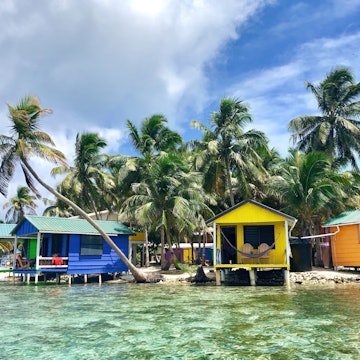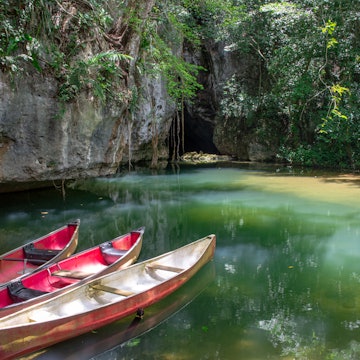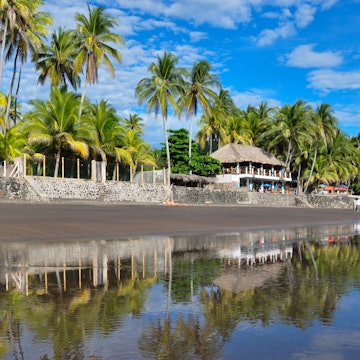

Walking is the best way to get to know different neighborhoods, like Casco Viejo © Ivan_Sabo / Shutterstock
Bound by the Panama Canal to the west, the Pacific Ocean to the south and a slew of protected rainforests to the north, Panama City has evolved on an eastward and upward trajectory, mushrooming along the shore in a sprawl of jagged glass skyscrapers.
Overhauling Panama City’s perpetually congested transport network has long been a priority for planners, particularly as the city’s population has grown by more than 700,000 since 2000. And today, billions of dollars in investment and years of hard work have finally paid off: Panama City now boasts the finest mass-transit system in Central America.
With modern buses and pioneering metro trains truly fit for a global destination, it has never been easier to get around this burgeoning metropolis.

Explore neighborhoods on foot
Panama City is not ideal for walkers. Most neighborhoods are a confusing warren of streets. Decent sidewalks are lacking, signage is poor and there are few designated road crossings, except for rickety pedestrian bridges that induce cold sweats and vertigo.
The roads are overrun with haughty motorists who firmly proclaim there’s only one right-of-way in the city: theirs. Panama City must be the only place where drivers speed up at the sight of a crossing pedestrian. Beware of those tinted windshields, too – it’s impossible to see or communicate with the person behind them.
All that said, walking is still the best way to see many parts of the city. Most neighborhoods are compact enough to navigate on foot, and once you have the lay of the land, you shouldn’t pass up the chance for a stroll. Of course, it’s best to use public transport to get between outlying districts; walking long distances in Panama City can be hot and bewildering.
Take a walking tour of Panama City's best areas
Walking is the only way to get under a city's skin, to feel its heartbeat. Nowhere is the life of Panama City felt more viscerally than in the gritty working-class districts of Santa Ana and Calidonia – the real Panama City, buzzing with chaos and street life.
Santa Ana evolved as a suburb of Casco Viejo, but unlike its polished neighbor, it’s not gentrified. Life gravitates to Parque Santa Ana, a crumbling plaza thronging with itinerant salespeople and shoe shiners.
From there, the crowded pedestrianized street of La Peatonal rambles east for a kilometer or so with a teetering procession of thrifty clothes stores and greasy fast-food joints, amped-up stereos pounding with bass.
Look out for Bajada Salsipuedes (Get-out-if-you-can) – a narrow alleyway crammed with pungent market stalls flogging curios and herbal medicines. La Peatonal concludes at the busy intersection of Plaza 5 de Mayo.
Keep heading east, and you’ll hit the mean streets of Calidonia, whose main avenue is shrouded in tattered awnings. For decades, the district has teemed with the helter-skelter commotion of impromptu market stalls, its air ripe with hot cooking fat, exhaust fumes, sweat and sweetish, fermenting fruit. Traffic roars. Music blares. Vendors hawk and holler for attention.
Continue marching east, and you’ll eventually emerge in the banking district, where the sanitized high-rise condos and glossy showrooms beckon another reality altogether.
Tips for walking in Panama City
Dress for the heat, pack water and keep a decent map in hand. Panama City is a patchwork of intriguing neighborhoods with endless options for an outing.
In the historic quarter of Casco Viejo, public transport is nonexistent and unnecessary; its streets are calm and compact, best explored at a deliberate pace.
Take care not to wander into the adjoining neighborhood of El Chorrillo – a dangerous place for tourists. The Cinta Costera, or Coastal Beltway, offers expansive views of the Pacific skyline, but the midday heat can be exhausting. Sunday evenings are the best and most popular time to stroll its length.
El Cangrejo is home to bars and restaurants on Vía Argentina, also worthy of an evening outing. And the former Canal Zone township of Balboa is quiet, leafy and eminently walkable, with commanding views of the canal from the top of Ancón Hill.
Buy a Metro card for public transport in Panama City
You’ll need a rechargeable Metro card to access the city’s network of Metrobuses and trains. If arriving at Tocumen International Airport, you can pick one up from a machine near the SIM-card kiosk for US$5, including $3 in preloaded fares.
If that’s not an option, head to your nearest Metro train station. Be sure to purchase an integrated card that permits travel on both trains and buses (the orange Metrobus cards will not work on trains).
And if you intend to use long-distance or intercity buses from Albrook terminal, you should get a three-in-one “RapiPass,” which gives you access to the departure platforms. Charge cards in Metro stations, supermarkets, kiosks and shops displaying the Metro logo. The minimum recharge is $0.50; the maximum is $50. You can use one card for up to four people.
Use Metro trains to cross the city in a flash
Inaugurated in 2014, Panama City’s Metro train system is the first of its kind in Central America, linking northern and eastern districts to the downtown area. The train helps alleviate the chronic tranques (traffic jams) that afflict city thoroughfares. The system currently includes two lines, with plans for three more and a light railway.
It’s a particularly convenient option if you lodge in the areas of El Cangrejo or Calidonia – much of Line 1 follows the path of Vía España. The nearest stop to Casco Viejo is Cinco de Mayo, which is some distance away. The Metro is the fastest and most convenient way to get to Albrook bus station.
The Metro operates Monday through Friday from 5am to 11pm, Saturday from 5am to 10pm and Sunday from 7am to 10pm. Trains depart every few minutes during rush hour. The fare for one journey is $0.35.
Use Metrobuses to access every inch of the city
Back in the day, Panama City’s urban buses were refurbished US school buses emblazoned with gaudy artwork, flashing neon lights and monstrous, thumping loudspeakers that boomed out reggaeton at top volume. Affectionately known as diablo rojos, the buses were hot, crowded and prone to breakdown. And as they crawled along the city’s arteries, they spewed out acrid clouds of black diesel smoke.
Today, the diablo rojos have been replaced by a fleet of exceedingly bland – but comparatively comfortable – modern, efficient, air-conditioned Metrobuses equipped with dependable Volvo engines. Some 1400 Metrobuses crisscross the city on more than 140 routes, making them the most comprehensive transport option in Panama City. Tocumen airport and the Amador Causeway are just two places that are only accessible by bus.
Use the MiBus website or app to check timetables and routes, or flag down a passing bus at a designated stop. Swipe your Metro card when you board. Fares are $0.25 per ride or $1.25 for the Corredor Norte or Sur (toll roads).
Each fare includes two free transfers (no returns), which must be used within 40 minutes. Remember to touch your card to the green validator at the back of the bus before exiting. Buses do not accept cash (except for the few surviving diablo rojos, which are cash only).
Routes converge at two main terminals: Albrook bus station – the hub for long-distance and intercity buses – and Plaza Cinco de Mayo, between the downtown neighborhoods of Santa Ana and Calidonia.

Only cycle on the Cinta Costera and Amador Causeway
Because of the lack of bike lanes and the aggressive nature of most Panama City motorists, cycling is not recommended. Two exceptions are the Cinta Costera, which has a dedicated lane for cyclists and rollerbladers, and the Amador Causeway, where bikes and family-style quad cycles can be hired for a casual pedal.
If you must use a bicycle to get around, restrict your travel to the weekends when traffic is light; early Sunday mornings are the time when crowds of cyclists head out for a spin.
Avoid driving in Panama City
Panama City residents are the most laidback people you will ever encounter…until they get behind the wheel. In my opinion, Panama City drivers are among the most aggressive in the Western Hemisphere. You won’t get far on the roads by being courteous and deferent; it pays to be aggressive.
Compared to public transport, driving is the least pleasurable and least efficient way to get around Panama City, particularly when you add congestion, flash floods, random diversions, obstructions, accidents, a lack of signage and a baffling one-way system to the mix.
If you relish a challenge, car rentals are available from Tocumen airport and at various outlets in the banking district. A cool head and GPS navigation are essential. Good luck!

Use taxis sparingly in Panama City
Taxis in Panama City are easy to find, but they're poor value compared to mass transit. Overcharging is rife, and you should avoid all taxis that wait outside hotels, as their rates are usually triple the standard fare. Short rides in the downtown area should cost $1.50 to $5.
Tips for taking taxis
You can hail passing cabs from major thoroughfares. After pulling over, the driver will roll down his window and ask where you’re going. Respond politely, and don’t be offended if he scowls and speeds off without you. Taxi drivers will often avoid destinations that involve congestion or complicated diversions.
Always try to agree on the fare before getting in. Ask: ¿por cuanto me lleva? (How long does it take?). Taxis are supposed to use a zone system to calculate fares (this rarely happens), so you can always ask to see the zone map in case of disputes.
Drivers may pick up other passengers en route to your destination. If you’re uncomfortable with this, tell them you want servicio exclusivo or no compartido. If you find a good driver, grab their cell phone number for future use. Taxi drivers don’t expect a tip unless they help with luggage.
Uber in Panama City is simpler and cheaper than taxis, with caveats
Uber is widespread in Panama City but also controversial, as the platform undercuts taxi drivers – and in fact, it's the subject of regular mass protests by city cab drivers.
Uber does cut out the song and dance of haggling over fares, and its vehicles are usually safer, cheaper and more reliable than yellow taxis, but there have been a few reports of drivers overcharging their customers by not turning off their meters after a journey.
Accessible transportation in Panama City
Panama City does not cater well to people with disabilities. The sidewalks are often in poor repair, with few ramps or designated street crossings.
On the other hand, Tocumen airport does offer wheelchair access, as do all Metro stations (in theory), with elevators for accessing the platforms. The trains have orange preferential seats, and the cars are equipped with buttons to call for assistance. Metrobuses contain two spaces for people with disabilities in the middle. Private vans with drivers can also be hired.
Many larger hotels are equipped with ramps, sizable bathrooms and grab rails. If you’re staying long-term or considering residency, parking permits are issued by La Secretaría Nacional de Discapacidad (SENADIS), the government agency responsible for protecting and enforcing the rights of people with disabilities. State support is generally weak, but the situation is slowly improving.
See our collection of Accessible Travel Online Resources for more information.
















